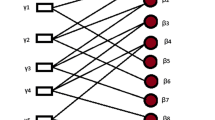Abstract
A transmission failure is caused by either signal attenuation, interference or both in wireless networks. Identification of such cause helps understanding of the current status of a wireless channel and network, thus providing essential information for optimizing the behavior of each network node as well as the operation of the whole network. In this paper, we propose a scheme to classify transmission failures in the receiver side (thus necessitating no change of existing protocols); the scheme detects an anomaly of the receive power pattern observed during an interference period and classify transmission events with the aid of a modem’s decoding result. The feasibility of the scheme is shown via a real experiment with its SDR implementation based on IEEE 802.15.4 ZigBee.






Similar content being viewed by others
References
Kamerman, A., & Monteban, L. (1997). Wavelan-II: A high-performance wireless LAN for the unlicensed band. Bell Labs Technical Journal, 2, 118–133.
IEEE P802.11ah: Sub 1 GHz License Exempt Operation, Std., Rev. D1.3, Apr. (2014).
Pang, Q., Liew, S., & Leung, V. (2005). Design of an effective loss-distinguishable MAC protocol for 802.11 WLAN. IEEE Communications Letters, 9(9), 781–783.
Kim, J., Kim, S., Choi, S., & Qiao, D. (2006). CARA: Collision-aware rate adaptation for IEEE 802.11 WLANs. In Proceedings of IEEE INFOCOM.
Whitehouse, K., Woo, A., Jiang, F., Polastre, J., & Culler, D. (2005). Exploiting the capture effect for collision detection and recovery. In Proceedings of IEEE EmNetS-II.
Yun, J.-H., & Seo, S.-W. (2007). Novel collision detection scheme and its applications for IEEE 802.11 wireless LANs. Computer Communications, 30(6), 1350–1366.
Rayanchu, S., Mishra, A., Agrawal, D., Saha, S., & Banerjee, S. (2008). Diagnosing wireless packet losses in 802.11: Separating collision from weak signal. In Proceedings of IEEE INFOCOM.
Sen, S., Choudhury, R., & Nelakuditi, S. (2012). CSMA/CN: Carrier sense multiple access with collision notification. IEEE/ACM Transactions on Networking, 20(2), 544–556.
USRP. Ettus Research. http://www.ettus.com/products.
Bloessl, F. D. B., Leitner, C., & Sommer, C. (2013). A GNU radio-based IEEE 802.15.4 testbed. In Proceedings of FGSN.
Acknowledgments
The work reported in this paper was supported by the National Research Foundation of Korea under Grant NRF-2014R1A1A2059515.
Author information
Authors and Affiliations
Corresponding author
Rights and permissions
About this article
Cite this article
Chua, H., Yun, JH. Classification of Transmission Events Based on Receive Power Pattern with Self-Tuning Thresholds in Wireless Receivers. Wireless Pers Commun 90, 1487–1495 (2016). https://doi.org/10.1007/s11277-016-3405-7
Published:
Issue Date:
DOI: https://doi.org/10.1007/s11277-016-3405-7




